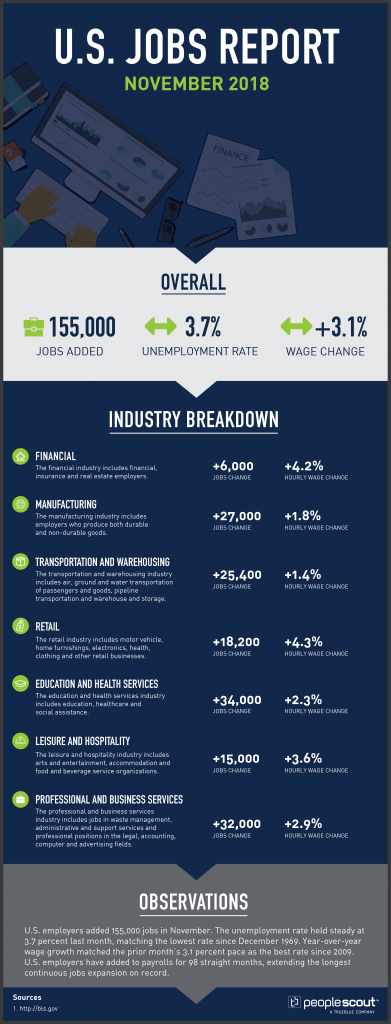The Labor Department released its November Jobs Report which shows 155,000 jobs added to the U.S. economy. The pace of hiring slowed while the unemployment rate remained at 3.7 percent, which is the lowest point since 1969. The participation rate also remained unchanged at 62.9 percent. U.S. employers have added to payrolls for 98 straight months, extending the longest continuous jobs expansion on record.

The Numbers
155,000: The economy added 155,000 jobs in November.
3.7%: The unemployment remained to 3.7 percent.
3.1%: Wages increased 3.1 percent over the last year.
The Good
The 155,000 jobs added to the economy in November adds to an unprecedented run of continuous growth. 2018 is shaping up to be a year of impressive expansion given the 12 month job growth in key sectors of the American economy: Healthcare employment has increased by 328,000; Manufacturing has grown by 288,000 and Business and Professional Services has expanded by 561,000 jobs.
The annual wage gain is also a sign that the economy is continuing to grow, but at a more measured pace than earlier in the year. As the New York Times reported:
“It’s obviously an economy that is well in expansion mode but that is coming off the boil after a strong second and third quarter,” said David Donabedian, chief investment officer of CIBC Private Wealth Management. “So the state of the job market is good. It’s just that the pace of job creation is slowing a little bit.”
Yearly wage growth remained at 3.1 percent for the second month in a row, a level not seen since the recession. “If you have solid wage growth while productivity is improving, that is the best of both worlds,” Mr. Donabedian said.
The Bad
The 155,000 jobs added in November fell below analyst expectations. The slowing pace of hiring is perceived to be caused by the inability of employers to find the right workers to fill their open positions. This appears to be the case in many parts of the economy, including those with some of the highest job gains this year such as healthcare. The Wall Street Journal reported on one such business in the high-demand area of elder care:
“The modest job-growth slowdown could be a sign of slightly softer demand for goods and services by consumers. For some companies, hiring also might be slowing because they can’t find the workers they need because unemployment is so low.”
That was the case for Home Instead Senior Care, an Omaha, Neb.-based in-home care provider, said its Chief Executive Jeff Huber. The company employs about 65,000 U.S. caregivers through its franchises, a 23 percent increase from three years ago.
“We could grow even more robustly if the labor market weren’t so tight,” Mr. Huber said. “The competitive job market is really restricting on our growth. There’s just tremendous demand for caregivers.”
Labor costs for the company, including wages and benefits, have risen about 20 percent annually in recent years, he said, but revenue is also growing robustly. The company is offering more training and flexible schedules to attract and retain employees, and recruiting older workers who have finished careers but aren’t ready to fully retire. A third of caregivers are older than 60, Mr. Huber said.
The Unknown
The recent announcement that General Motors would be laying off nearly 14,000 workers raises the question of whether these newly available workers would have the skills required to find new work, even in the current labor market in which job seekers are highly favored. This point was underscored by General Motors CEO Mary Barra:
“As Barra announced the cutbacks, she also said GM plans to acquire “skillsets of the future” by hiring in software development, battery and fuel cell technology and autonomous vehicle development,” The Detroit News reported. “You will see us having new employees join the company as others are leaving,” she said. “We still need many technical resources across the company.”
![[Webinar] Smart Hiring in the AI Age: What UK Candidates Are Really Doing in 2025](https://www.peoplescout.com/wp-content/uploads/2025/05/AI-enable-applicant-report-320x320.jpg)
